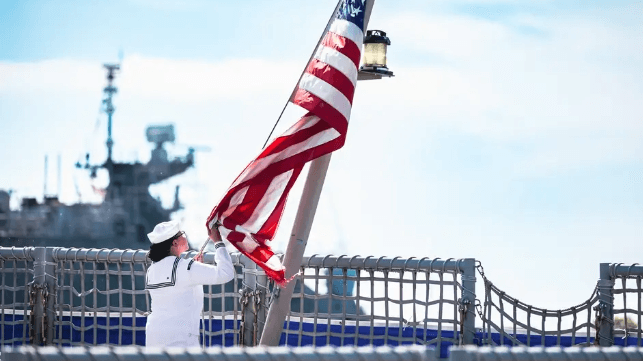USS Sioux City Decommissions After Less Than Five Years in Service
Service life was among the shortest since World War II

In a ceremony at Naval Station Mayport on Monday, the Freedom-class littoral combat ship USS Sioux City was decommissioned 20 years ahead of her expected lifespan. The vessel was the most accomplished of her class, having deployed four times for operations overseas.
USS Sioux City headed into retirement four years and nine months after she was commissioned. According to naval commentator Chris Cavas, this ranks among the fastest decommissionings since the Second World War.
During her brief time in service, the ship deployed to U.S. Fourth, Fifth and Sixth Fleet. She was the first and only LCS to operate in U.S. Fifth Fleet, the main region where the class was designed to serve. She also carried out successful counter-narcotics patrols in U.S. Fourth Fleet, helping U.S. Coast Guard boarding teams capture over 10,000 kilograms of cocaine worth an estimated $500 million.
“It’s tempting to engross oneself with the finality of the process. Let us not lose sight of the memories we have made, the culture we have built, successes we have had and will endure forever," said Commander Michael Gossett, Sioux City's last commanding officer.
The U.S. Navy has an interest in offloading its Freedom-class LCS vessels, which have high maintenance and operating costs but limited lethality and survivability in a high-end fight. The ultimate cancelation of a planned anti-submarine warfare package also removed the ships' utility as a platform for sub-hunting. The third-party ASW package for the Freedom-class was canceled in 2022 after repeated developmental delays, and according to then-Chief of Naval Operations Adm. Mike Gilday, the small warships are "as noisy as an aircraft carrier" - an inbuilt challenge for sensitive ASW sonar systems.
In 2022, the service proposed early retirement for every commissioned vessel of the type then in service, a total of nine hulls. The House Appropriations Committee limited this divestment plan to four ships in the FY2023 spending bill.
The Freedom-class was designed by an aircraft manufacturer, and the Navy specified an unusually high top speed and low cost as its key design requirements. Achieving 40-plus knots in an affordable, conventionally-powered monohull meant accepting tradeoffs for armament and armor, resulting in a lightly-armed patrol vessel with limited utility in a near-peer conflict. This concern was identified by the program's critics as early as 2016.
The torque produced by the high-powered powerplant also proved too much for the vessel's original combining gear, destroying clutch bearings and requiring expensive gearbox replacements. This problem has been fixed for the additional Freedom-class LCS hulls still under construction.
Both the Freedom-class and the (entirely different) Independence-class littoral combat ships are costly to operate - nearly as costly as a combat-capable Arleigh Burke-class destroyer, according to 2021 budget projections. Navy officials say that it would be less expensive to down-select to a single LCS design, keeping the Independence-class and treating most of the early Freedom-class hulls as a sunk cost. The Navy could have taken the choice to down-select to one hull design at the outset of LCS production in 2010-11, but opted to continue with two separate programs. It considered the same choice during a review in 2017 and again opted to keep both.
